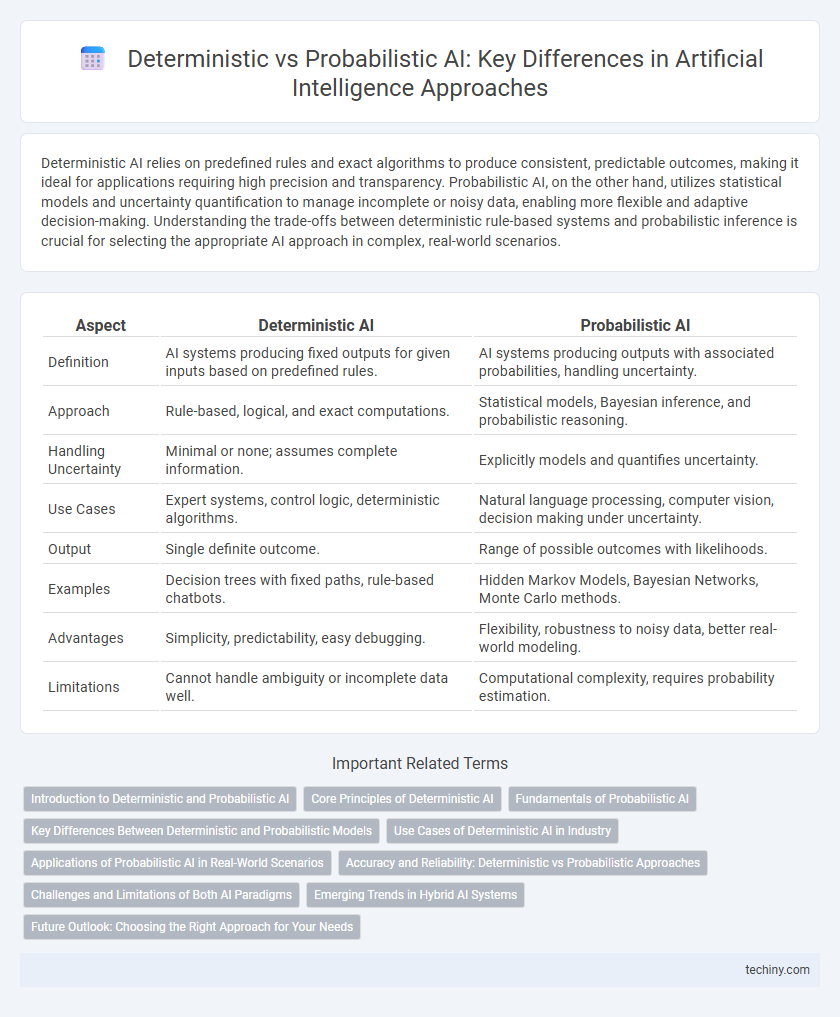Deterministic AI relies on predefined rules and exact algorithms to produce consistent, predictable outcomes, making it ideal for applications requiring high precision and transparency. Probabilistic AI, on the other hand, utilizes statistical models and uncertainty quantification to manage incomplete or noisy data, enabling more flexible and adaptive decision-making. Understanding the trade-offs between deterministic rule-based systems and probabilistic inference is crucial for selecting the appropriate AI approach in complex, real-world scenarios.
Table of Comparison
| Aspect | Deterministic AI | Probabilistic AI |
|---|---|---|
| Definition | AI systems producing fixed outputs for given inputs based on predefined rules. | AI systems producing outputs with associated probabilities, handling uncertainty. |
| Approach | Rule-based, logical, and exact computations. | Statistical models, Bayesian inference, and probabilistic reasoning. |
| Handling Uncertainty | Minimal or none; assumes complete information. | Explicitly models and quantifies uncertainty. |
| Use Cases | Expert systems, control logic, deterministic algorithms. | Natural language processing, computer vision, decision making under uncertainty. |
| Output | Single definite outcome. | Range of possible outcomes with likelihoods. |
| Examples | Decision trees with fixed paths, rule-based chatbots. | Hidden Markov Models, Bayesian Networks, Monte Carlo methods. |
| Advantages | Simplicity, predictability, easy debugging. | Flexibility, robustness to noisy data, better real-world modeling. |
| Limitations | Cannot handle ambiguity or incomplete data well. | Computational complexity, requires probability estimation. |
Introduction to Deterministic and Probabilistic AI
Deterministic AI operates on predefined rules and fixed algorithms, producing predictable and consistent outcomes based on specific inputs. Probabilistic AI leverages statistical models and uncertainty quantification to generate predictions that account for variability in data, enabling robust decision-making under ambiguous conditions. Understanding the distinction between deterministic and probabilistic approaches is crucial for selecting the appropriate AI model depending on the complexity and nature of the problem domain.
Core Principles of Deterministic AI
Deterministic AI operates on fixed algorithms and predefined rules, ensuring consistent outputs for identical inputs by eliminating uncertainty. Core principles emphasize algorithmic transparency, repeatability, and logical inference, relying on structured data and formal logic to drive decision-making. This approach contrasts probabilistic AI, which incorporates randomness and statistical models to handle ambiguity and incomplete information.
Fundamentals of Probabilistic AI
Probabilistic AI fundamentally relies on probability theory and statistical methods to model uncertainty and make predictions based on incomplete or noisy data. Unlike deterministic AI, which produces fixed outputs from given inputs, probabilistic AI represents knowledge through probability distributions, enabling it to handle ambiguous or uncertain environments effectively. Key tools include Bayesian networks, Markov models, and Monte Carlo simulations that facilitate reasoning under uncertainty and improve decision-making in real-world applications.
Key Differences Between Deterministic and Probabilistic Models
Deterministic AI models operate with fixed rules and produce consistent, predictable outputs given the same inputs, emphasizing precise and rule-based logic. Probabilistic AI models incorporate uncertainty and randomness, leveraging statistical methods to handle incomplete or ambiguous data, which enables better adaptation to real-world variability. Key differences include deterministic models' reliance on strict algorithms versus probabilistic models' use of likelihoods and probabilistic inference to make decisions under uncertainty.
Use Cases of Deterministic AI in Industry
Deterministic AI excels in industries requiring precise, repeatable outcomes, such as manufacturing automation, robotic process automation (RPA), and quality control systems. It enables manufacturing plants to maintain consistent product standards by strictly following predefined rules and conditions. In finance, deterministic models streamline fraud detection by applying fixed criteria to transactional data, ensuring reliable and transparent decision-making.
Applications of Probabilistic AI in Real-World Scenarios
Probabilistic AI excels in applications like medical diagnosis, where uncertainty in symptoms and test results requires models that estimate likelihoods rather than definitive outcomes. In autonomous driving, probabilistic AI helps predict pedestrian movements and environmental changes, improving decision-making under uncertain conditions. Financial risk assessment leverages probabilistic models to evaluate market fluctuations and investment risks, enhancing portfolio management strategies.
Accuracy and Reliability: Deterministic vs Probabilistic Approaches
Deterministic AI models produce consistent and exact outcomes by following predefined rules, enhancing reliability in applications requiring high accuracy and repeatability. Probabilistic AI incorporates uncertainty and variability, allowing it to handle ambiguous data and improve decision-making in complex, real-world scenarios. While deterministic approaches excel in predictable environments, probabilistic methods often achieve better overall accuracy by modeling uncertainty and adapting to new information.
Challenges and Limitations of Both AI Paradigms
Deterministic AI often struggles with inflexibility and difficulty adapting to uncertain or dynamic environments due to its reliance on predefined rules and logic. Probabilistic AI, while better at handling uncertainty and incomplete data, faces challenges in computational complexity and interpretability, making it harder to explain decisions. Both paradigms encounter limitations in scalability and robustness, highlighting the need for hybrid approaches to address diverse real-world applications.
Emerging Trends in Hybrid AI Systems
Emerging trends in hybrid AI systems combine deterministic AI's rule-based precision with probabilistic AI's ability to manage uncertainty, enhancing decision-making accuracy in complex environments. These systems leverage symbolic reasoning alongside machine learning models to improve interpretability and robustness in applications such as autonomous driving and healthcare diagnostics. Integration of hybrid AI frameworks accelerates advancements in adaptive algorithms capable of learning from incomplete or noisy data while adhering to predefined logical constraints.
Future Outlook: Choosing the Right Approach for Your Needs
Deterministic AI offers precise and predictable outcomes ideal for applications requiring consistent decision-making, while probabilistic AI excels in handling uncertainty and complex data patterns in dynamic environments. The future landscape of AI development favors hybrid models that integrate deterministic rules with probabilistic reasoning to maximize accuracy and adaptability. Selecting the right approach depends on specific use cases, data availability, and the level of risk tolerance in decision processes.
Deterministic AI vs Probabilistic AI Infographic

 techiny.com
techiny.com